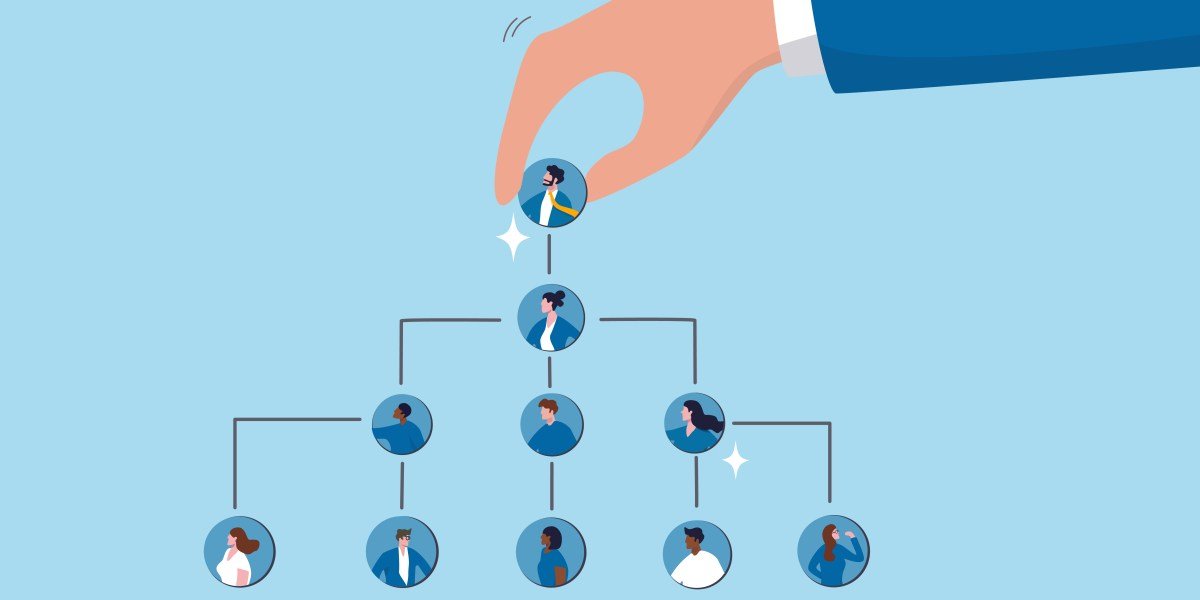
Artificial intelligence already changes the Org planning for companies

The traditional Org plan is subject to companies, an elegant triangle of power with executives at the top and base workers, to a quiet revolution, thanks to artificial intelligence.
In Moderna, HR and Tech now lives under the same ceiling supervised by one president and a digital employee. At another company from Ai-Purst Healthcare, a team of 10 software engineers has been replaced by three people overseeing artificial intelligence agents. In Amazon, layers of middle management are stripped as part of a wider batch towards a smaller and ready -made structure.
AI is not just a new tool for the location of modern work; It reshapes how companies are organized.
We call it “great flattening”.
With the race of business leaders to integrate artificial intelligence through their operations, beginners roles disappear, management classes, and the traditional team roles began to rupture. Through Fortune 500, the middle administration strikes, as well as novice workers, but even in C-SUITE, the new energy dynamics in playing with the start of the old pyramid structure for corporate life in the settlement.
The heads of technology were keen to promote a vision as artificial intelligence automated the work of work, which puts the official while allowing soft skills and creativity to prosper. “I think with artificial intelligence and work with my colleagues,” said Microsoft Satya Nadella earlier this year.
While the utopian idea of a world without tasks such as editing Excel or file sorting tables look great in theory, how does the first organization look actually in practice?
Artificial intelligence flattening
One of the main topics of institutions that have “AI-FIRST” structures is a type of “flattening” of the company’s structure, which mainly means less layers of management supervision, removal of beginners or support roles, and increasing dependence on artificial intelligence systems to deal with the tasks that have been dealt with by human employees.
It can also mean collapse or mixing traditional team structures.
For example, Modern Pharmaceutical Company It recently merged the technology and human resources departments into one job, and appointed senior digital technology employees to oversee both teams. This step, according to the Wall Street Journal, was partially driven by the company’s partnership with Openai and the company tending to artificial intelligence to help deal with things such as human resource support and some beginner roles.
At Consulting GIANT MCKINSEY, the company publishes thousands of artificial intelligence agents to support consultants in tasks such as building floors, summarizing research, and checking the logic of arguments. Moreover, about 40 % of the company’s revenue now comes from advice on artificial intelligence and relevant technologies.
“If you are Amnesty International, you can use artificial intelligence agents to do a lot of implementation work for institutions,” Nick South, Administrative Director and a great partner in Boston Consulting GroupHe said luck. “And when we organize our operations and delivery operations on these original workforce Amnesty International, the role of humans, then, is different.”
Partially due to the fact that the nature of individual job roles will change as the tasks are automatically by the tools or agents of artificial intelligence.
“Our career roles may be dismantled, because some tasks may be seized by artificial intelligence and others, and therefore the meaning, or functional change function,” said Eva Celinso, a professor of psychology at Laboro College of Labor Business College. “You may need less than the role, but this person will take another job of something else.”
This does not mean that the entire jobs will be replaced, but this may mean that employee roles become more diverse and take over tasks outside the normal duties, or even their usual team. Celino said that the role of jobs is dismantled with automatic tasks, and its importance changes in the organization. As a result, strict divisions may begin between the difference.
Mix all this with a few artificial intelligence factors who do independent, and the traditional Org scheme begins to look very different.
“Now we move to this flat network of human difference that oversees artificial intelligence agents,” said Rob Levin, a partner at McKinsey & Company.
He said: “In early examples, we see that a customer company is building a agent factory that supports many multiple business flows, about 50 to 100 Amnesty International agency can be managed by only two or three people only.”
In one example, Levin said that the healthcare company replaced a traditional software development team of 10 people with three smaller units. These consist of a product owner, a software engineer who can effectively claim artificial intelligence coding tools, and an architect who guarantees integration with the company’s broader technology environmental system.
However, these types of major structural changes are easier to implement in smaller institutions or startups instead of large companies that have more complex structures.
The plight of the middle director
One of the ways that companies, especially in the technology sector, tried to simplify and settle their structures for the age of artificial intelligence is to reduce employees at the administrative level. For example, the CEO of Palantir Alex Karp announced in a profit call on Monday that he intends to turn 500 of his 4,100 employees. He called it “Crazy and effective revolution”
Mediterranean managers have taken many managers, especially from the big executives such as Andy Jassy, who said that medium managers can hinder speed, ownership and innovation in Amazon, especially in the context of AI’s organizational change.
Jassy is currently following the structure of the Amazon company by increasing the percentage of individual shareholders to managers, with the aim of removing classes and simplifying decisions.
However, the experts said luck Organizations should not count medium managers yet.
Treistan told. Botelho, associate professor of organizational behavior at Yale College of Management: “One of the clear possibilities (skipping organizations) is that it will cause a kind of administrative mitigation.” “If artificial intelligence reduces the burden of coordination, the role of the middle administration, whose mission previously was to make these links.”
However, although artificial intelligence may change how medium managers work, Botelho is not expected to completely disappear.
He said: “I do not think that the middle administration will be erased. I think it will determine how managers think about their role within the organization.” “There is one thing I am talking about a lot with CEOs … this is the kind of ideas that artificial intelligence integrated with the organization must … raise your level of skills as a manager.”
In the era of artificial intelligence, soft skills also become of increasing importance, as medium managers serve vital human resources functions. Employees still have to manage, and the workforce still needs to work with sympathy or organizations that risk losing their best performance.
“There is a human aspect of things,” said Stella Paci, a great lecturer in technology and work at King’s Business College. “It is not sustainable that you only have a coach as an algorithm, it will not work in the long run.”
Unlike the great technology novel, some experts say that the administrative class will expand within the traditional organizational structures as automation replaces low -level business.
Nick South from BCG said luck These functions will be at the level of implementation, which are usually at the bottom of the Org scheme, the first in the cutting block due to artificial intelligence factors, while the administrative “synchronization” level or “will grow in complexity and importance.
He said: “In the synchronization layer, it should be greater than it is today … There will be a decisive human part of that, which is related to making sure that all these things do things.”
“If you are considering the classic Middle Manager profile, this is a kind of general manager’s skills group. But what these people will need in the future is a mixture of adequate artificial intelligence to manage human workforce and agency, as well as basic skills of logic, understanding ethics, rhetorical skills, and communication skills, so that they can communicate with others in the organizations that have been set much less,” he said. “So these synchronization roles will be very complicated.”
New C-SUITE
Although Mediterranean managers and novice employees may feel the burden of artificial intelligence, these changes go directly to the top.
Artificial intelligence already transfers energy dynamics in C-SUITE and creating new jobs at the executive level. According to 2023 Miscolic study on artificial intelligence Priorities, 11 % of medium to large -sized companies have already been appointed by someone to be “chief artificial intelligence officials” (CAIO), while additional 21 % are under employment in this role.
According to the LinkedIn 2023 report on Amnesty International at workCompanies with the position of “President of Amnesty International” multiplied around the world more than three times in the five years, by 13 % from 2022.
Alex Konok, an older colleague at the University of Oxford University, has noticed the growth of these roles directly.
“While it may have been relatively rare when we first launched Amnesty International for Business Programs a few years ago, we now have a lot of people … in our executive courses with the title of senior artificial intelligence employees.” luck. “It is the new dominant. The level of attention exceeds all levels, from 20 -year -old university students … even experienced executives. ”
While there is some debate about whether these roles will face a time test, for example, Experts said These roles can lack a clear purpose or authority, the executive level is not immune to the mutation of artificial intelligence.
South said that although the rise of some of these roles can also be a symptom of our lack of maturity with artificial intelligence rather than the direct need for this work, C-SUite still should assume new responsibilities in the era of artificial intelligence.
“People feel extremely tense from losing a boat,” he said. “I think it will be interesting to see how this develops over time … where things stabilize, how different this is with classic data officials?”
But the following is “a new responsibility in C-SUITE … to think about our competitive scene, where possible sources of disruption, and how we protect our sources of feature. These are C-SUITE questions, and it will be a mistake to think about strategic, if we employ a major officer in artificial intelligence, we leave it in some way.
While artificial intelligence has been set to disable all levels of organizations, Selenko indicated that management structures are likely to protect those at the top of the disorders.
She said: “In the affected management structure, if they can be partially by artificial intelligence, it will not give up this strength. So I think you will see that this transformation in the energy balance may be more than among the lowest positions in the organization.”













Post Comment